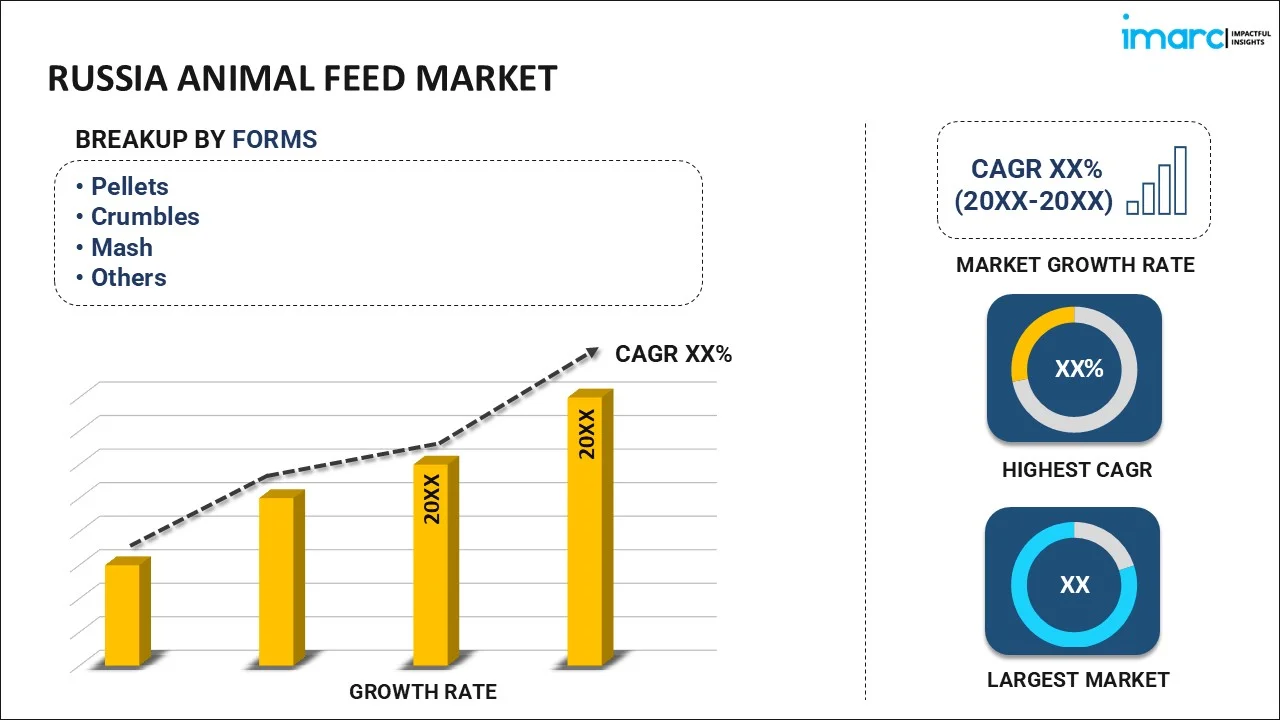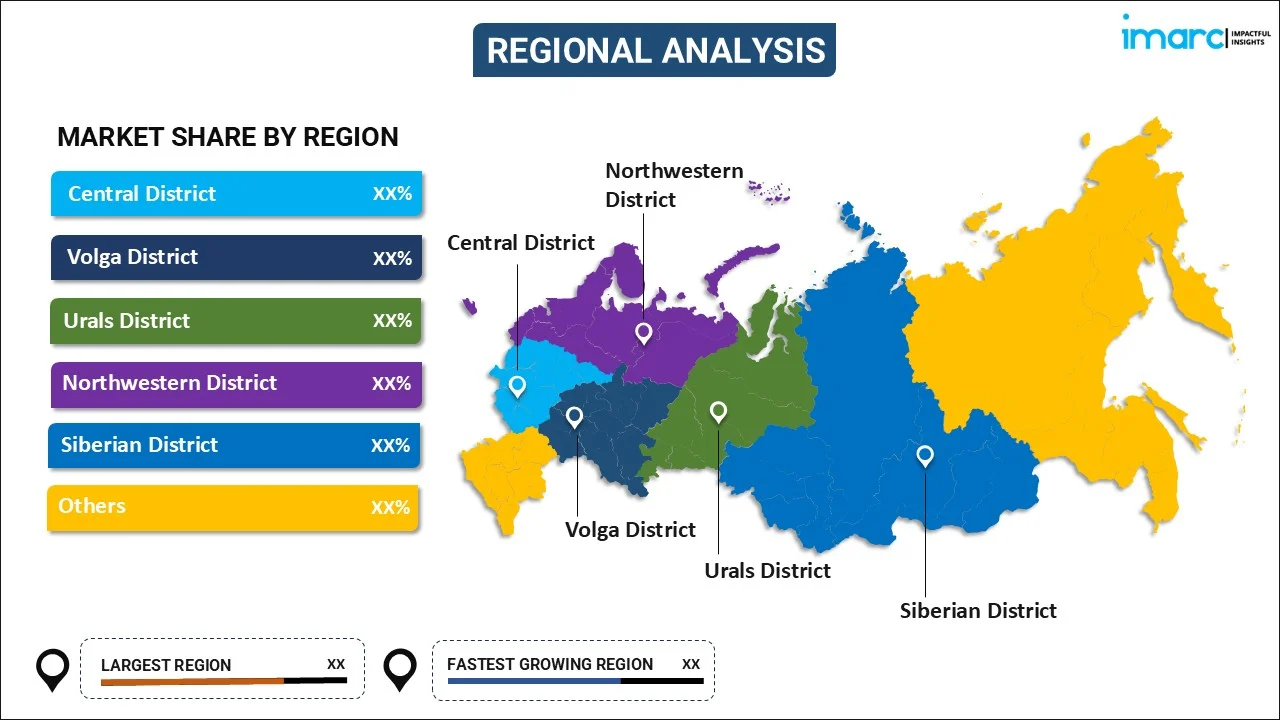
Russia Animal Feed Market Report by Form (Pellets, Crumbles, Mash, and Others), Animal Type (Swine, Ruminants, Poultry, Aquaculture, and Others), Ingredient (Cereals, Oilseed Meal, Molasses, Fish Oil and Fish Meal, Additives, and Others), and Region 2025-2033
Russia Animal Feed Market Overview:
The Russia animal feed market size reached 36.2 Million Tons in 2024. Looking forward, IMARC Group expects the market to reach 47.6 Million Tons by 2033, exhibiting a growth rate (CAGR) of 2.98% during 2025-2033. The market is driven by the expanding livestock and poultry industry, technological advancements in feed production, government support and favorable policies, increasing domestic feed production capabilities, and the rising demand for high-quality, specialized animal feed products.
|
Report Attribute
|
Key Statistics
|
|---|---|
|
Base Year
|
2024
|
|
Forecast Years
|
2025-2033
|
|
Historical Years
|
2019-2024
|
| Market Size in 2024 | 36.2 Million Tons |
| Market Forecast in 2033 | 47.6 Million Tons |
| Market Growth Rate 2025-2033 | 2.98% |
Russia Animal Feed Market Trends:
Growing Livestock and Poultry Industry
One of the major drivers of the Russian animal feed market is the expansion of the livestock and poultry industry. As domestic meat consumption increases and export opportunities grow, there is a heightened demand for high-quality animal feed to support the nutritional needs of livestock and poultry. For instance, the Russian Union of Feed Manufacturers projects a 14.3% increase in feed production to 40 million tonnes by 2025. Poultry feed is expected to grow by nearly a third to 22 million tonnes, and cattle feed by 28% to 3.8 million tonnes. Fish feed is forecasted to rise from 400,000 tonnes to 700,000 tonnes. The industry meets domestic demand with a production capacity of 42 million tonnes in 2023, expected to increase to 45 million tonnes by 2025. The Russian government’s initiatives to modernize agricultural practices and improve productivity have also led to an increase in livestock farming operations. These advancements necessitate the use of specialized feeds that enhance growth rates and overall health of the animals. Consequently, the feed industry is seeing a surge in demand for various feed types, including compound feeds, premixes, and additives that cater to specific nutritional requirements.
Government Support and Policies
Government support and favorable policies play a crucial role in driving the Russian animal feed market. The Russian government has implemented various programs and subsidies aimed at boosting the agricultural industry, including the livestock and poultry sectors. Initiatives such as financial incentives for feed producers, subsidies for modernizing feed mills, and support for research and development in animal nutrition are encouraging the growth of the feed market. For instance, according to industry reports, Russia is implementing mandatory labeling for pet food and veterinary drugs starting September 1, 2024, to combat counterfeit products, which constitute up to 25% of sales in some segments. Beginning October 1, all dry pet food must carry labels for complete supply chain traceability, with wet pet food labeling to start on March 1, 2025. The reform aims to eliminate counterfeit products and improve market integrity.
Moreover, the government’s focus on improving food security and reducing dependency on feed imports is fostering domestic production. For instance, in the first half of 2024, Russia saw a 40% decline in pet food imports as compared to the previous year. This drop is attributed to government restrictions, increased domestic production, and difficulties in making payments for imported goods, particularly from politically friendly countries. However, Russia has authorized the import of animal meal used in feed from Brazil, following negotiations between the Brazilian Ministry of Agriculture and Russia's Federal Veterinary and Phytosanitary Surveillance Service (Rosselkhoznadzor). Initially, 11 Brazilian companies are approved to export, with ongoing efforts to expand this number. Regulations and standards set by government agencies ensure the quality and safety of animal feed, thereby gaining the trust of farmers and feed manufacturers and propelling market expansion.
Russia Animal Feed Market News:
- In March 2024, Cherkizovo Group, Russia's largest meat producer, announced that it has acquired Venta-Oil in the Orenburg region to enhance feed supplies for its pig facilities. The facility includes a feed production unit with a 50,000 metric ton annual capacity, a 54,000-ton grain elevator, two grain dryers, and a certified laboratory. This acquisition supports Cherkizovo’s vertical integration strategy, improving biosecurity and feed quality for pig breeding operations, which accommodate over 250,000 pigs annually.
Russia Animal Feed Market Segmentation:
IMARC Group provides an analysis of the key trends in each segment of the market, along with forecasts at the country level for 2025-2033. Our report has categorized the market based on form, animal type, and ingredient.
Form Insights:

- Pellets
- Crumbles
- Mash
- Others
The report has provided a detailed breakup and analysis of the market based on the form. This includes pellets, crumbles, mash, and others.
Animal Type Insights:
- Swine
- Starter
- Finisher
- Grower
- Ruminants
- Calves
- Dairy Cattle
- Beef Cattle
- Others
- Poultry
- Broilers
- Layers
- Turkeys
- Others
- Aquaculture
- Carps
- Crustaceans
- Mackeral
- Milkfish
- Mollusks
- Salmon
- Others
- Others
A detailed breakup and analysis of the market based on the animal type have also been provided in the report. This includes swine (starter, finisher, and grower), ruminants (calves, dairy cattle, beef cattle, and others), poultry (broilers, layers, turkeys, and others), aquaculture (carps, crustaceans, mackeral, milkfish, mollusks, salmon, and others), and others.
Ingredient Insights:
- Cereals
- Oilseed Meal
- Molasses
- Fish Oil and Fish Meal
- Additives
- Antibiotics
- Vitamins
- Antioxidants
- Amino Acids
- Feed Enzymes
- Feed Acidifiers
- Others
- Others
The report has provided a detailed breakup and analysis of the market based on the ingredient. This includes cereals, oilseed meal, molasses, fish oil and fish meal, additives (antibiotics, vitamins, antioxidants, amino acids, feed enzymes, feed acidifiers, and others), and others.
Regional Insights:

- Central District
- Volga District
- Urals District
- Northwestern District
- Siberian District
- Others
The report has also provided a comprehensive analysis of all the major regional markets, which include Central District, Volga District, Urals District, Northwestern District, Siberian District and Others.
Competitive Landscape:
The market research report has also provided a comprehensive analysis of the competitive landscape in the market. Competitive analysis such as market structure, key player positioning, top winning strategies, competitive dashboard, and company evaluation quadrant has been covered in the report. Also, detailed profiles of all major companies have been provided.
Russia Animal Feed Market Report Coverage:
| Report Features | Details |
|---|---|
| Base Year of the Analysis | 2024 |
| Historical Period | 2019-2024 |
| Forecast Period | 2025-2033 |
| Units | Million Tons |
| Scope of the Report | Exploration of Historical Trends and Market Outlook, Industry Catalysts and Challenges, Segment-Wise Historical and Future Market Assessment:
|
| Forms Covered | Pellets, Crumbles, Mash, Others |
| Animal Types Covered |
|
| Ingredients Covered |
|
| Regions Covered | Central District, Volga District, Urals District, Northwestern District, Siberian District, Others |
| Customization Scope | 10% Free Customization |
| Post-Sale Analyst Support | 10-12 Weeks |
| Delivery Format | PDF and Excel through Email (We can also provide the editable version of the report in PPT/Word format on special request) |
Key Questions Answered in This Report:
- How has the Russia animal feed market performed so far and how will it perform in the coming years?
- What has been the impact of COVID-19 on the Russia animal feed market?
- What is the breakup of the Russia animal feed market on the basis of form?
- What is the breakup of the Russia animal feed market on the basis of animal type?
- What is the breakup of the Russia animal feed market on the basis of ingredient?
- What are the various stages in the value chain of the Russia animal feed market?
- What are the key driving factors and challenges in the Russia animal feed?
- What is the structure of the Russia animal feed market and who are the key players?
- What is the degree of competition in the Russia animal feed market?
Key Benefits for Stakeholders:
- IMARC’s industry report offers a comprehensive quantitative analysis of various market segments, historical and current market trends, market forecasts, and dynamics of the Russia animal feed market from 2019-2033.
- The research report provides the latest information on the market drivers, challenges, and opportunities in the Russia animal feed market.
- Porter's five forces analysis assist stakeholders in assessing the impact of new entrants, competitive rivalry, supplier power, buyer power, and the threat of substitution. It helps stakeholders to analyze the level of competition within the Russia animal feed industry and its attractiveness.
- Competitive landscape allows stakeholders to understand their competitive environment and provides an insight into the current positions of key players in the market.
Need more help?
- Speak to our experienced analysts for insights on the current market scenarios.
- Include additional segments and countries to customize the report as per your requirement.
- Gain an unparalleled competitive advantage in your domain by understanding how to utilize the report and positively impacting your operations and revenue.
- For further assistance, please connect with our analysts.
 Inquire Before Buying
Inquire Before Buying
 Speak to an Analyst
Speak to an Analyst
 Request Brochure
Request Brochure
 Request Customization
Request Customization




.webp)




.webp)












